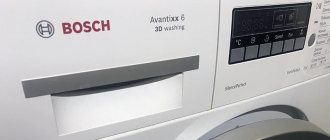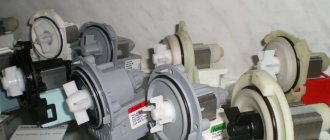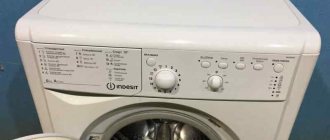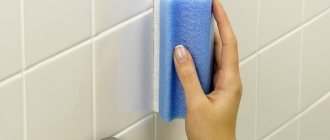From scale From mold At home From dirt Automatic Clean the compartments Clean the pump Simple methods Tips for the home From plaque From dirt Tips suitable for washing machines: Zanussi LG Indesit Ariston Atlant Electrolux Hansa LG Candy (Kandy) Samsung Bosch (Bosch), etc.
Cleaning the washing machine. We extend the service life of the automatic machine. We analyze all the methods of cleaning from dirt, scale, fungus, etc.
We are so accustomed to convenience that now not a single housewife can imagine her life without an automatic washing machine. And only the most low-income families do not have it, where they still wash in a basin, but still plan to buy it.
What could be the reasons for contamination in the washing machine and what can you expect:
- Moisture may cause mold to appear on the rubber seal;
- During operation, scale appears on the heating element;
- Residues of washing powder stick;
- The drain pump filter is dirty;
- Rust or stones appear in the inlet hose filter.
All this leads to an unpleasant odor and rapid breakdown of the washing machine. And in order to avoid damage from dirt, you should periodically clean the car either with special products or with handy ones that you find at home.
How to clean a washing machine filter
If you do not clean the filters in time, then soon after they become dirty and clogged, you can cause a severe flood.
What do you need to clean the filter? Prepare a rag, a flat container and a screwdriver. Find the panel at the bottom (most often it is the socket on the bottom left), open it and unscrew the filter. Before doing this, do not forget to place a flat container and keep a rag ready, since a small amount of water will still spill out from there.
Once you open the filter, remove all dirt and accumulated debris. By the way, sometimes you can find interesting things there). Next, wipe the hole, screw on the filter and close the lid tightly.
How to clean a washing machine from smells
Sometimes your washing machine may smell musty. This is due to the fact that you could take cheap, poorly dissolving and leaching detergents. They accumulate on the walls and cause an unpleasant odor later.
If you do not dry your car, mold or mildew may appear, which also gives off an unpleasant odor and stains your clothes.
- Always rinse the tray after every third wash.
- If the channel from where the detergent enters the machine is clogged, clean it with a small brush containing chlorine.
- Clean the drain filter
- Clean your washing machine from limescale
Such manipulations will help you get rid of odors and extend the life of even an old washing machine.
Rules of care
To prevent contamination of the washing machine, and in particular the detergent drawer, you must:
- Install a water softener in front of the machine;
- Wash the car after each wash;
- After use, leave the door open to allow moisture to evaporate;
- Systematically clean the powder tray;
- Use only high-quality and expensive powders from well-known manufacturers;
- Rinse the car additionally after using bleaches.
How to descale a washing machine
We clean the heating element itself and the washing drum from scale, since this is where the heating elements are located. Over time, mineral deposits of salts and lime adhere to these elements. Essentially, these are Magnesium and Calcium salts. Therefore, the best thing is to remove it with acids. At home it is vinegar and citric acid.
Recipes:
- Clean with vinegar: 2 cups 9% table vinegar, 1/4 cup baking soda. Pour the mixture of water and soda into the powder container, and vinegar into the drum itself. We turn it on for maximum operating time at the highest temperature. If there is a boiling function, use it.
- Citric acid: Citric acid 1-6 packs depending on the contamination. If you haven’t cleaned it for a long time, then more is better. Pour the acid directly into the powder compartment. Turn on the longest wash and temperature mode, as in the first case.
- Soda. 500 grams of baking soda are poured into the drum, and 1 liter of 9% table vinegar is poured into the receiving tray. The program with the highest temperature is set. This option will help you clean not only the tank and heating element, but also the drain channels.
How to clean a washing machine drum
Why might the drum become dirty? There are several options for contamination:
- Sand and dust from dirty clothes
- Grains of sand and particles of rust from the water supply
During washing, these solid particles combine with limescale impurities from the water and gradually stick (settle) on the drum. It is especially difficult to clean the inner, invisible part of the drum from contamination.
When you start cleaning your car, follow these steps:
- Wipe the walls of the drum with a damp cloth, thereby wetting the surface and also removing large dirt;
- Pour baking soda onto a damp cloth and thoroughly clean the drum. Baking soda removes scale, grease and accumulated dirt;
- Leave the soda for half an hour and then wash off the remaining dissolved dirt with a clean cloth;
- Add diluted vinegar, bleach or citric acid to the powder tray. What is at hand;
- Set the maximum wash time at a temperature of 60ºC and without the rinse function;
- After finishing the program and draining the water, put the machine on a double rinse to completely remove any remaining solution in the tank.
This way you can protect your car from wear and tear in time and extend the service life of both the heating element and the tank.
System health check
Upon completion of cleaning, you need to check the Indesit machine for functionality by turning it on in the accelerated wash mode with mandatory rinsing.
After waiting for the end of the cycle, you need to carefully monitor the process of draining the water and make sure there are no failures . If you find that the signs of clogging have not disappeared, you will have to disassemble the filter again and consult with specialists about its condition.
Problems after
Sometimes, when draining after cleaning, waste water begins to seep out from under the technical hatch door. This means that during assembly the filter housing is not installed tightly enough. You will have to remove it again and re-install it.
Sometimes the cause of smudges and signs of clogging is complete wear of the filter element. In this case, after receiving confirmation from professionals, you will need to dismantle it and replace it with a new product.
How to clean an elastic band in the washing machine
The rubber in the machine serves as a seal and also gets clogged like other parts. Both dirt particles and water accumulate under it, which can cause fungus to develop or mucus to form. It’s not very pleasant if dirt from under the elastic gets onto clean linen.
To prevent the formation of deposits, do preventive maintenance after each wash:
- Use a cloth to dry any remaining water under the rubber band;
- Leave the car door open for a while. so that it dries completely;
- Try to ventilate the room itself from moisture where the washing machine is located.
If you already have a fungus, the following ingredients will help you clean it:
- Soda
- Dishwashing liquid
Mix baking soda and dish liquid approximately 1:1. Using a sponge, apply the resulting solution to the entire surface of the elastic inside, rub it and leave for half an hour. Then rinse it thoroughly and wipe with a dry cloth. If the contamination is very strong, then take any disinfectant that does not contain chlorine.
Chlorine-containing cleaners can corrode the rubber seal or deform it.
How to clean mold from a washing machine
Mold can appear not only under the rubber seal. If it is in a damp and cool room, then every part can become “infected” with fungus. Constantly wet parts are especially susceptible to infection: the elastic band, the tray and the drain.
If you do not get rid of it in time, then not only the machine, but also the person living in the apartment may suffer. The fungus produces a huge number of bacteria that cause allergies and pulmonary diseases.
How you wash your clothes also affects mold.
- Wash only on cold cycles up to 40°C. This temperature does not kill the fungus, but only creates favorable conditions for spores to reproduce and develop.
- Washing without the use of active bleaching agents. Gentle powders without chlorine and phosphates cannot kill the fungus. But the active substances will help get rid of it even if you decide to bleach your bed linen.
- Using air conditioning. When using it, it is necessary to include an additional rinse to wash away the remaining conditioner from the walls of the machine. The laundry will remain with the same properties that you would rinse once. If you use a one-time rinse, the remaining conditioner will remain on the walls. And this is a favorable environment for the development of mold.
Stages of cleaning the washing machine from mold:
- Wash the tray, rubber seal and other contaminated visible parts of the machine with laundry soap;
- Pour regular white into the dispenser and put it on a long wash;
- In the middle of the cycle, stop the machine for 30-60 minutes;
- Pour 2-3 cups of 9% vinegar into the measuring tank and set to rinse;
- After washing, wipe the machine dry.
This method helps in advanced cases when you need to clean not only externally, but also internally the entire washing machine.
How to clean a washing machine tray
If you only need to clean the tray, use the following method:
- Remove the tray. This can be done in almost every car. You can simply pull out the tray all the way
- Spray with any universal cleaner;
- Rinse using the hard side of a sponge or a toothbrush;
- Rinse thoroughly and wipe dry.
The tray is the first step to contamination with mold, rust, etc. Try to care for it as often as possible, dry it after each wash, rinse it as soon as you see plaque appearing. And then your washing machine will serve you for a long and faithful service.
Possible difficulties
The drain filter is not always easy to unscrew from its seat. This problem occurs when the device is cleaned too rarely. The limescale layer accumulated at the junction of the part with the thread does not allow them to be separated. In such a situation, you have to remove the filter along with the pump. You can get the device by placing the washing machine on the floor with its side wall in such a way as to provide access to its bottom.
The bottom of the pump can be covered with a lid. It should be unscrewed, the pump separated from the pipes (by removing the clamps) and disconnecting the wires from the terminals. Unscrew the bolts used to secure the device to the drain system. Apply WD-40, which is good at removing rust and deposits, to the connection between the pump and the filter. Disconnect the parts. If this method does not help, carefully break off the filter element without damaging the pump threads. Now the old filter needs to be replaced with a new one.
Traditional methods of cleaning a car
How to clean a washing machine with citric acid
Citric acid is used for light stains, unpleasant odors in the car, and also as a preventive measure for heating element scale and for cleaning the drum. At the same time, if you compare it with expensive purchased products and read the composition, you will see that 75% of the product consists of acid. When compared, the benefits are obvious.
The procedure for cleaning the machine with citric acid:
- 50-100 grams of lemons are placed in a powder tray
- Select the longest washing mode and the highest temperature of 90 degrees
- After finishing the wash, set the machine again for an additional rinse.
If there is still a smell after cleaning, don’t despair. There is an explanation for this:
- You haven’t cleaned your washer for a very long time and after running it, all the plaque hasn’t been removed.
- With constant washing at 40 degrees, bacteria and fungus spread on the walls and it is already difficult to get rid of it
In such cases, repeat the cleaning procedure. After this, wipe the car dry and dry it with the hatch and tray open.
Remember! This is prevention. And it is advisable to use this method no more than once every 6 months.
How to Clean a Washing Machine Using Baking Soda
Soda helps get rid of mold, because when dissolved it creates an alkaline environment, which fungus does not like so much. Most often it is distributed on the sealing rubber, in the drum itself, in the powder tray.
Mode of application:
- Make a paste: half a glass of water and half a glass of soda, mix well to obtain a homogeneous mass.
- Apply a little paste to a sponge and wipe the affected area thoroughly. Try to use rubber gloves during the procedure
- Leave for a while and wipe with a damp cloth
- Turn the machine on to rinse mode
If you take citric acid and soda, you can partially get rid of scale, if the contamination is not severe6
- Take 150 g of citric acid and 2-4 teaspoons of baking soda
- Pour this mixture into the powder tray
- Turn the washing machine on the longest cycle at the highest temperature. When finished, repeat the rinse cycle again.
How to use vinegar when cleaning
Vinegar is used less frequently, but it can also be used for mildew or mildew.
- Pour 9% vinegar into the tray for liquid laundry detergent - 2 cups
- We start the machine at high temperature and select the longest washing mode
- After 10-15 minutes have passed, turn off the washing machine for a couple of hours in order to kill the fungus
- Next, continue washing and additionally set to rinse mode after stopping
- Wipe the entire interior surface and rubber seal with a soft cloth dampened with vinegar solution.
- Wipe the machine dry with a dry cloth and leave to dry with the hatch and tray open.
Interesting! Some housewives add 1-2 tablespoons during washing to soften the water and prevent scale. And if you add apple cider vinegar, you can get a pleasant smell for your laundry.
Cleaning the washing machine with bleach
Bleach, also known as Whiteness, helps fight mold and disinfect the most inaccessible places.
How to properly use bleach when cleaning:
- Pour 100 ml of white directly into the washing machine (drum)
- Turn on the mode with a temperature of 90 degrees for 30-40 minutes
- Then run an extra rinse
Use Whiteness no more than once every six months. When using Domestos, be careful - it tends to foam.
The best chemicals for cleaning automatic machines
If you still trust store-bought products more, then it is better to buy specialized drugs sold in specialized stores. The most purchased and popular ratings among users:
- Topperr 3004 (Germany) – suitable for descaling dishwashers and washing machines. Recommended by Bosh manufacturers.
- Schnell Entkalker (Germany) - quickly helps to get rid of lime deposits on internal elements.
- Antikalk for Washing Machines from Sano (Israel) is a universal gel for the prevention and elimination of small plaque with an antibacterial effect.
- Magic Power (Germany) is one of the best specialized products for washing machines. Available in the form of gel and powder, which effectively removes plaque from heating elements, tanks, and drums.
- Beckmann (Germany) is a universal product that will protect against scale and eliminate unpleasant odors caused by various contaminants. But, like any multi-purpose product, it is good for regular care, but will be ineffective against heavy dirt.
- Filtero 601 (Germany) – works well to remove old scale from the heater and other elements; it is recommended to use 3-4 times a year for intensive cleaning of the machine. Available in 200 g bags for one use.
- Doctor TEN (Russia) and Antiscale (Belarus) are inexpensive drugs that help remove scale from any heating elements.
- Bork K8P1 (Korea) – will clean scale. In stores it is sold in a package of 4 sachets.
- Shumanit Bagi (Israel) – gets rid of scale, limescale, and rust. Cleans surfaces well.
All these products are available in convenient packages in the form of powder or liquid products. I usually buy liquid products that contain bleach, which helps get rid of limescale and mildew.
These products also clean other appliances: irons, dishwashers, etc.
Cleaning the powder drawer
The detergent tray is another “vulnerable” place in any washing machine. Powder particles constantly settle on the walls of the dispenser, and if the container is not cleaned in time, it will become covered with a thick layer of plaque. Therefore, it is recommended to wash the cuvette after each use of the equipment.
Some people have a question about how to get the powder receptacle out of the housing. In fact, everything is simple:
- pull the dispenser all the way in your direction;
- With your free hand, press the tab located above the central compartment of the tray;
- Pull the cuvette further until it is completely removed.
You can clean the detergent container using citric acid. To do this, take hot water (temperature 50-60°C) into a basin and add 250 grams of lemon into it. Then you have to stir the liquid until the granules are completely dissolved. The tray must be soaked in the solution for a couple of hours. Next, you need to take out the cuvette, clean it with a brush, wipe it with a cloth and rinse.
When cleaning the powder receptacle, you can use special household chemicals or improvised means: citric acid, vinegar, soda.
A clean dispenser must be wiped dry with a rag and placed back into the housing. There are special guides in the niche, exactly along which you need to insert the tray.
How to Clean a Top Loading Washing Machine
Top-loading machines also need to be cleaned periodically, as they accumulate even more bacteria, mucus and mold.
- We use the longest and highest temperature washing cycle
- Add 2-3 cups of 9% vinegar to the water, after a couple of minutes add half a cup of soda
- This starts the reaction. Leave the equipment in this form for 1.5-2 hours on pause
- While the machine is standing, wash the outside of it with a vinegar solution with a soft cloth.
- After the time has passed, turn on the machine and finish washing
- Wipe the inside with a cloth to remove any remaining dirt.
The best protection for household appliances is keeping not only the body clean, but also the cuffs and insides. As soon as the automatic parts become clogged, problems may appear: leaks, failure. Therefore, do not forget to take preventive measures that are easy to do yourself. Below is a small instruction that you need to know before launching our assistant to prevent frequent repairs.
Washing hygiene
Automatic washing machines are designed to save the owner from unnecessary hassle. But are they really independent? You load clothes into the drum, add powder, press a button and after a while you get clean clothes. Particles of dirt, lint, threads and pet hair remain in the drum.
Only part of this small debris enters the filtration system and is discharged into the sewer. Tiny fractions settle on the walls, where they become an ideal environment for the proliferation of pathogenic fungi and bacteria.
You load new clothes, and all this microflora ends up on things, because the standard washing mode involves heating the water only in the range of 30-60°C. This temperature is not enough to kill pathogens.











